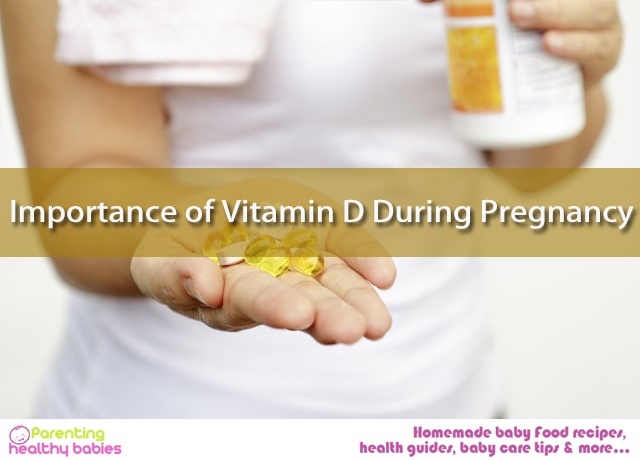Child-bearing days are quite eventful and stressful in a woman’s life. The increased nutritional needs to sustain herself and her little one leaves her exhausted. Pregnancy increases the need of vital nutrients in the body to nurture and support the growing baby and then finally make the major event-delivery successful.
Read More: 8 Symptoms of Vitamin D Deficiency That You Should Know
Importance of Vitamin D during pregnancy
Vitamin D is one of the many essential nutrients needed by the human body while pregnant or otherwise. It is a fat soluble vitamin which aids the absorption of calcium, magnesium and phosphate by the intestine. Very little food sources are known to contain vitamin D, but adequate exposure to sunlight helps in the synthesis of of vitamin D in the body.
Read More: 21 Food that are Rich in Vitamin D
Benefits of vitamin D during pregnancy
Vitamin D requirements are higher during pregnancy, especially during the second and third trimister. Some important points are listed below, indicating the benefits of vitamin D to the expecting mother and baby:
* Musculoskeletal development in the baby: Muscles and bones start developing in the fetus by the second trimister. This leads to increase in the requirement of calcium in the body which in turn increases the need of vitamin D as vitamin D aids calcium absorption.
* It reduces pregnancy complications like gestational diabetes, preeclampsia, preterm labour or birth, low birth weight etc.
* It also helps in reducing maternal hyperparathyroidism – a condition caused by overactivity of parathyroid glands and osteomalacia where the bones soften due to the deficiency of vitamin D.
* Vitamin D also helps in fighting infections and prevent some types of cancers.
* It helps in making the bones and teeth stronger and prevents diseases like rickets in the infant.
* It also helps in preventing autoimmune diseases like neurological and caediovascular diseases in the expecting mother.
Read More: Vitamin D Deficiency in Children: 8 Symptoms Every Parent Should Know
Symptoms of vitamin D deficiency
Pregnant women with insufficient vitamin D in their bodies experience aching muscles, bone pain and softened bones leading to fractures.
Top 21 food sources providing vitamin D
Naturally occuring food sources rich in vitamin D are very few. Some of them are listed below, let’s have a look:
1) Eggs
One of most easily available and easy to cook food item is egg. 1 egg contains about 40 IUs of D vitamin. Including eggs in your diet not only gives you taste but also lots of other nutrients.
2) Tuna fish
Its not only a great source of vitamin D, but is also filled with heart healthy omega-3 fatty acids. 4 ounce of tuna contains 150 IUs of vitamin D.
3) Mushrooms
Most mushrooms are grown in the dark and do not contain vitamin D. But some kind of mushrooms are grown in UV light to spur vitamin D production in them. Dole’s portobellos will give you 400 IUs of vitamin D per 3-ounce serving (about 1 cup of diced mushrooms).
4) Fortified orange juice
One 8-ounce glass of fortified juice usually has around 100 IUs of vitamin D, but the amount varies from brand to brand. Not all brands are fortified, so check the label.
5) Beef liver
A 3.5 ounce of cooked beef liver contains 50 IUs of vitamin D. But since beef is high in cholesterol one should limit the intake.
6) Swiss cheese
Cheese contains little amounts of vitamin D. 1 ounce contains 6Iu of the vitamin.
7) Sardines
Oil canned sardines contain 46 IUs per serving.
8) Cod-liver oil
It is an excellent source of vitamin D where 1 tablespoon contains about 1360 IUs.
9) Swordfish
3 ounces of cooked swordfish contains 566 IUs.
10) Salmon
Salmon otherwise called sockeye when cooked contains 447 IUs per 3 ounce.
11) Fortified margarine
1 table spoon contains 60 IUs of vitamin D.
12) Fortified yoghurt
6 ounces of yogurt is fortified with 20% of the DV for vitamin D.
13) Fortified milk
Fortified milk, whole or skimmed, 1 cup contains 115-124 IUs of vitamin D.
14) Instant cereals
Ready-to-eat cereals fortified with vitami D contain 40 IUs per cup.
15) Mackerel
3 ounces: 400 IU (100% DV).
16) Caviar
1 oz: 33 IU (8% DV)
17) Fortified soymilk
Milk substitutes like soy milk contains 291 IUs per cup.
18) Shiitake and button mushrooms
Sun-dried shittake and button mushrooms are also good sources of vitamin D.
19) Herring
Herring are high in vitamin D because they thrive on plankton, which is a hearty source of vitamin D.
20) Catfish
Catfish are a freshwater fish that have a habit of feeding on minuscule organisms that use sunlight to produce vitamin D.
21) Sunshine
Vitamin D is also called “sunshine vitamin”. When our skin is exposed to sun vitamin D is produced from cholesterol.
References:
https://www.webmd.com
https://www.myfooddata.com
